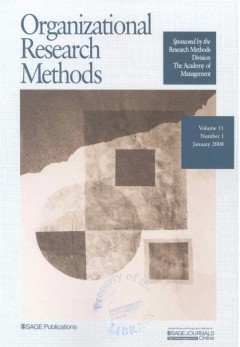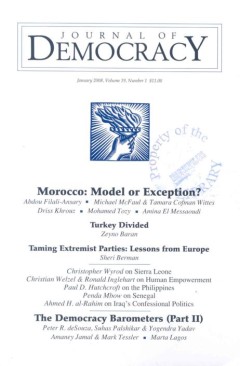Filter by

Not seeing the joke : the overlooked role of humour in researching television…
This article argues that humour can provide researchers with a unique access point into the professional cultures of media producers. By reconsidering an earlier case study, and reviewing relevant literature, it illustrates how humour can fulfil several functions in media production. Importantly, humour is a central means of performing the ‘emotional labour’ that increasingly precarious media w…
- Edition
- Vol. 33 no. 6, September 2011,pp. 819-833
- ISBN/ISSN
- 01634437
- Collation
- -
- Series Title
- Media Culture Society
- Call Number
- -

‘You’re all a bunch of pinkos’ : Rupert Murdoch and the politics of Har…
News Corporation is one of the most closely studied international media conglomerates, headed by the world’s most famous media proprietor. Yet, despite its prominence in the academic literature, little attention has been paid to the company’s book publishing operations. This article seeks to rectify this oversight. It investigates some of the more controversial book deals made by HarperCollins,…
- Edition
- Vol. 33 no. 6, September 2011,pp. 835-850
- ISBN/ISSN
- 01634437
- Collation
- -
- Series Title
- Media Culture Society
- Call Number
- -

The management of emotion in British journalism
This article reports on a study which aimed to assess how much attention journalism training and practice currently pay to the idea of emotional literacy, to explore what need news journalists and current affairs filmmakers see for closer evaluation of the emotional dimensions of their work, and to outline a strategy for enhancing emotional literacy in journalism training. While focused on enco…
- Edition
- Vol. 33 no. 6, September 2011,pp. 851-867
- ISBN/ISSN
- 01634437
- Collation
- -
- Series Title
- Media Culture Society
- Call Number
- -

The media as ‘home-making’ tools : life story of a Filipino migrant in Milan
According the World Tourism Organization (UNWTO) there are 850 million international passenger arrivals each year; and according to the United Nations Refugee Agency (UNHCR), in 2008 there were 42 million refugees across the globe. The condition of mobility, in all its spatial and temporal variations is a condition of daily life in a globalized world. Even those who are lucky enough not to be f…
- Edition
- Vol. 33 no. 6, September 2011 ,pp. 869-883
- ISBN/ISSN
- 01634437
- Collation
- -
- Series Title
- Media Culture Society
- Call Number
- -

A system in chaos? Knowledge and sense-making on immigration policy in public…
This article shows how press selection and presentation of knowledge and expertise relate to processes of sense-making over contemporary political dilemmas. It develops an approach that combines framing analysis with theoretical insights from the literature on narrative and complexity. It demonstrates the value of this approach through quantitative and qualitative analysis of media coverage of …
- Edition
- Vol. 33 no. 6, September 2011,pp. 885-904
- ISBN/ISSN
- 01634437
- Collation
- -
- Series Title
- Media Culture Society
- Call Number
- -

Entertaining ideas : social issues in entertainment television
The educational potential of entertainment television has been acknowledged, with varying degrees of enthusiasm, through research into entertainment-education strategies, intersections of politics and popular media, and the mediated public sphere. This article explores educational possibilities of entertainment programming through a consideration of British television programmes that challenge …
- Edition
- Vol. 33 no. 6, September 2011,pp. 905-921
- ISBN/ISSN
- 01634437
- Collation
- -
- Series Title
- Media Culture Society
- Call Number
- -

Protest 2.0 : online interactions and Aboriginal activists
Social movements, like every other aspect of life, have become increasingly reliant on the internet for networking, information sharing and coalition building. This is the case even for disadvantaged groups with few resources and less capacity for utilizing computers and the internet. Aboriginal activists in Townsville have been slow to exert their presence on the web, but are gradually becomin…
- Edition
- Vol. 33 no. 6, September 2011,pp. 923-940
- ISBN/ISSN
- 01634437
- Collation
- -
- Series Title
- Media Culture Society
- Call Number
- -

Telenovela writers under the military regime in Brazil : Beyond the cooption …
This article aims to analyse the strategic choices made by left-wing telenovela writers during the military regime in Brazil, their complex relationships with their employer, Globo Network, and the regime’s various forms of censorship. The arrival of many critical cultural producers in the television industry during the authoritarian period in Brazil (1964—85) and the alleged close links betwee…
- Edition
- Vol. 33 no. 5, July 2011,pp. 659-673
- ISBN/ISSN
- 01634437
- Collation
- -
- Series Title
- Media Culture Society
- Call Number
- -

Symbolic power and the internet : The power of a ‘horse’
It is a common perception that as long as people have the resources to access the internet, they are in a position to make their voice heard. In reality, however, it is obvious that the vast majority of internet users are not really able to make themselves ‘visible’ and that their concerns receive little attention. Thus, it is more accurate to suggest that the internet offers ordinary people th…
- Edition
- Vol. 33 no. 5, July 2011,pp. 675-691
- ISBN/ISSN
- 01634437
- Collation
- -
- Series Title
- Media Culture Society
- Call Number
- -

Audience labor in the new media environment : A Marxian revisiting of the aud…
The contemporary dynamics of mass communication necessitate a reassessment of the received notions of audience labor. To that end this article revisits Dallas Smythe’s seminal audience commodity theory through the lens of a two-sided class analysis. A number of his key conceptualizations are critiqued including audience power, audience measurement, media content as a free lunch, audiences as a …
- Edition
- Vol. 33 no. 5, July 2011,pp. 693-708
- ISBN/ISSN
- 01634437
- Collation
- -
- Series Title
- Media Culture Society
- Call Number
- -

Creating digital enclaves : Negotiation of the internet among bounded religio…
This article examines the motivation behind bounded groups’ creation of digital enclaves online. Through in-depth interviews with 19 webmasters and staff of selected Israeli Orthodox websites three critical areas of negotiation are explored: (1) social control; (2) sources of authority; and (3) community boundaries. Examining these tensions illuminates a detailed process of self-evaluation whic…
- Edition
- Vol. 33 no. 5, July 2011, pp. 709-724
- ISBN/ISSN
- 01634437
- Collation
- -
- Series Title
- Media Culture Society
- Call Number
- -

Running the race : Competition discourse and broadband growth in Aotearoa New…
The objective of this study is to understand key aspects of contemporary discourse surrounding telecommunications development in Aotearoa New Zealand after the privatization of telecommunications in the late 1980s. We identify various characteristics of discourse on competition and telecommunication and trace how competition discourse was rhetorically positioned in attempts to produce economic,…
- Edition
- Vol. 33 no. 5, July 2011,pp. 725-742
- ISBN/ISSN
- 01634437
- Collation
- -
- Series Title
- Media Culture Society
- Call Number
- -

Communications and transport : The mobility of information, people and commod…
In a context where the study of communications tends to focus only on the mobility of information, to the neglect of that of people and commodities, this article explores the potential for a closer integration between the fields of communications and transport studies. Against the presumption that the emergence of virtuality means that material geographies are no longer of consequence, the role…
- Edition
- Vol. 33 no. 5, July 2011 ,pp. 743-759
- ISBN/ISSN
- 01634437
- Collation
- -
- Series Title
- Media Culture Society
- Call Number
- -

Television news and democratic change in India
This article examines the impact of India’s ‘television news revolution’, or the rapid growth of privately owned television news channels, on substantive democracy, or the ability of ordinary citizens to access social, political, and economic power. Existing scholarship has largely relied upon content analysis (or textual interpretation) and reception studies to address this question. In contra…
- Edition
- Vol. 33 no. 5, July 2011,pp. 761-777
- ISBN/ISSN
- 01634437
- Collation
- -
- Series Title
- Media Culture Society
- Call Number
- -

Digital spaces, material traces : How matter comes to matter in online perfor…
This article argues that in order to cultivate a more thorough understanding of how gender, sexuality and embodiment come to ‘matter’ in digital environments, it is necessary to reconsider the notion of the virtual as it relates to everyday reality, in addition to rethinking the digital in relation to our common conception of materiality. To develop such an understanding, the discussion is orga…
- Edition
- Vol. 33 no. 4, May 2011,pp. 531-547
- ISBN/ISSN
- 01634437
- Collation
- -
- Series Title
- Media Culture Society
- Call Number
- -

Adjusting for a Mediator in Models With Two Crossed Treatment Variables
In a simple mediation model, the effect of a manipulated variable X on a dependent variable Y over and above the effect of the mediator Me can be estimated by regressing Y on X and Me. The impact of X on Y in such a model is adjusted for the relationship both between X and Me and between Me and Y. The authors examine the adjustment function in the context of a 2 x 2 design with two manipu…
- Edition
- Vol. 11, No. 2, Page 224-240
- ISBN/ISSN
- 1094-4281
- Collation
- -
- Series Title
- Organizational Research Methods
- Call Number
- -

An Illustration of the Consequences of Meta-Analysis Model Choice
Fixed- and random-effects models represent two different approaches to analyzing and understanding data with meta-analysis. The current article describes the results of a two-part study to illustrate the effect of choice of meta-analytic model on study conclusions. Part 1 illustrates the effect of model choice by analyzing data simulated to conform to either fixed- or random-effects scena…
- Edition
- Vol. 11, No. 1, Page 35-53
- ISBN/ISSN
- 1094-4281
- Collation
- -
- Series Title
- Organizational Research Methods
- Call Number
- -

Genocide and its aftermath: The case of Rwanda
This article describes the experiences of returnees from exile into Kigali, Rwanda and the efforts of the Government of Rwanda (GoR) and the UNHCR to meet the needs of returnees, and to deal with the aftermath of the genocide. Particular attention is paid to the Gacaca courts and the role of social work therein. We identify gaps in services and make recommendations in respect of the r…
- Edition
- Vol. 51, No. 3, Page 324-336
- ISBN/ISSN
- 0020-8728
- Collation
- -
- Series Title
- International Social Work
- Call Number
- -

Taming Extremist Parties: Lessons From Europe
A rise in the power of Islamist parties has lent fresh interest to the old question of how revolutionary movements respond to participation in democracy. Pessimists argue that such movements will use any power they gain at the ballot box to subvert democracy, while optimists believe that participation can turn extremists into moderates. The example of 20th century European communist parti…
- Edition
- Vol. 19, No. 1, Page 5-18
- ISBN/ISSN
- 1045-5736
- Collation
- -
- Series Title
- Journal of Democracy
- Call Number
- -

‘Eternal ephemera’ or the durability of ‘disposable literature’ : The…
Popular and academic discussions of the future of print focus on the electronic formats of books and newspapers but ignore some of the most ubiquitous and historically significant, albeit ephemeral, types of print media. This article argues for taking the flyer, leaflet and pamphlet seriously. These forms of ‘disposable literature’ are in part facilitated by electronic media and in part able to…
- Edition
- Vol. 33 no. 4, May 2011,pp. 515-530
- ISBN/ISSN
- 01634437
- Collation
- -
- Series Title
- Media Culture Society
- Call Number
- -
 Computer Science, Information & General Works
Computer Science, Information & General Works  Philosophy & Psychology
Philosophy & Psychology  Religion
Religion  Social Sciences
Social Sciences  Language
Language  Pure Science
Pure Science  Applied Sciences
Applied Sciences  Art & Recreation
Art & Recreation  Literature
Literature  History & Geography
History & Geography